Beekeeping leads to Honey Queen title for ISU sophomore
April 30, 2010
Amber Connett started her beekeeping hobby when she was 16 years old with an FFA scholarship, a beehive, equipment and a mentor.
Now Connett, a sophomore in agricultural education, is the queen of her hobby.
Connett was last year’s North Central Regional Queen, and was named the Iowa Honey Producers’ Association’s 2009-10 Iowa Honey Queen last October.
With the crown and sash comes the responsibility of educating the state about the bee population and their honey-producing habits.
Connett mainly travels to grocery stores and elementary schools across the state to promote and discuss the honey industry.
A part of her job is clearing up misconceptions about the insects.
“Bees actually don’t attack, like people think they do,” Connett said.
“They’re really gentle and docile — as long as you’re not messing with them, they won’t mess with you.”
She said she’s been stung only three times and all three times it was because of something she did.
Connett said she consistently has one or two hives at her home in Monroe and hopes to have closer to ten after she graduates.
Each hive, however, consists of 60,000 to 80,000 bees in the peak of summer and weighs about 150 pounds.
She said she likes how her honeybees pollinate her garden and provide great subjects for her photographs, but she’s “not a big honey fan.”
“I never really liked honey all that much, but my family really likes honey so I make it for them,” Connett said.
Raising honeybees is a year-long process, she said.
Worker bees collect nectar and pollen in the spring and summer for food and bring it back to the hives to feed the queen bee, her babies and the drones.
During the cooler months of the year, Connett said she might have to provide the hive with sugar water if it’s too cold for the bees to be outside gathering food.
In the fall, the honeybees produce honey.
“It takes 12 bees to produce one teaspoon of honey,” Connett said.
Worker bees kick the drones out of the hives during the winter months and form a ball around the queen bee to keep her alive.
During this time, beekeepers are bottling honey for personal or commercial use.
Connett said she encourages consumers to purchase honey that is produced locally here in Iowa.
She said the cheaper honey on the shelves of many grocery stores may be labeled as “a product of the U.S.,” but they are often mainly bottles of corn syrup with a trace amount of honey.
The Queen also encourages Iowans to: “plant more gardens so bees can eat” and to not “smash” bees.







